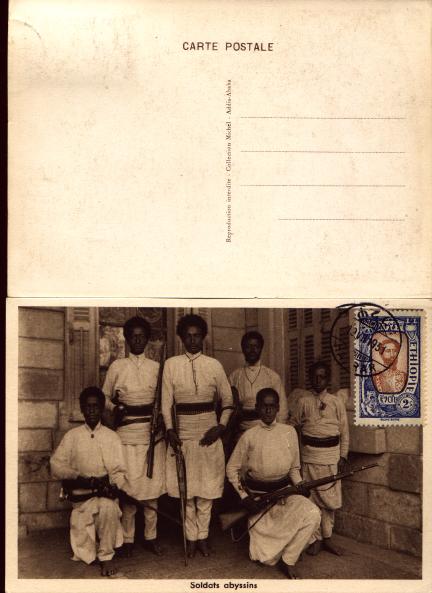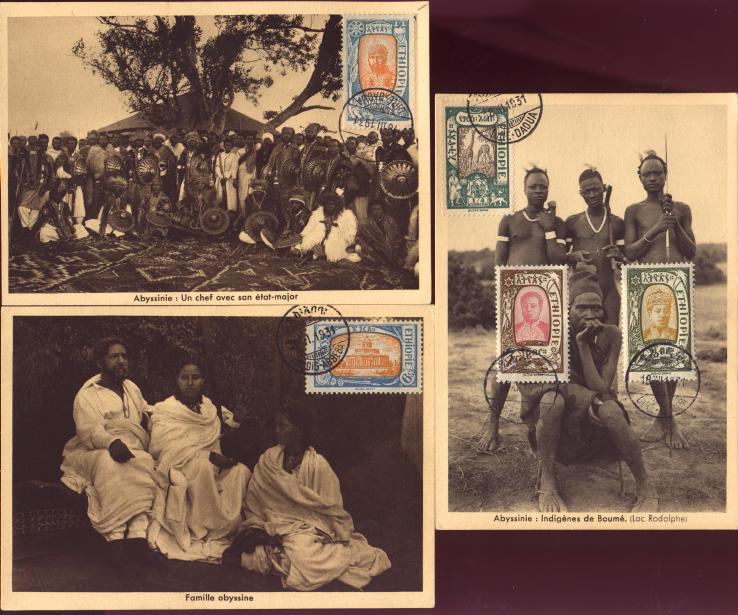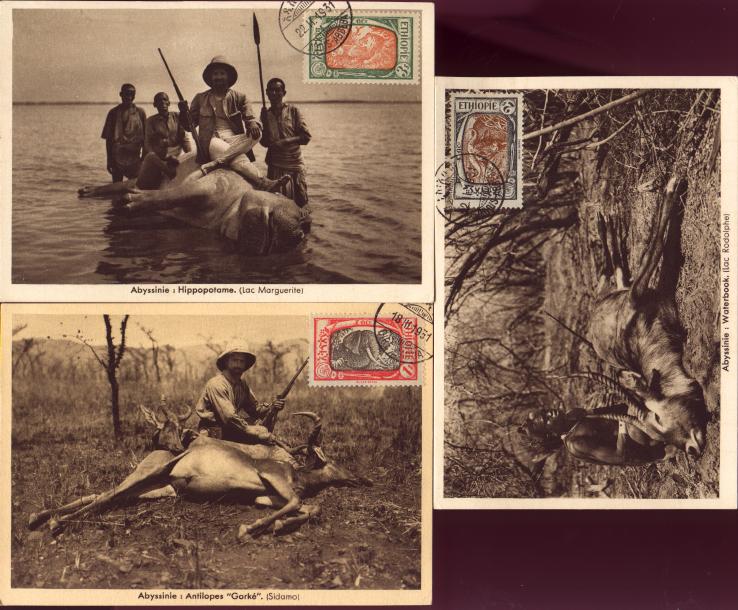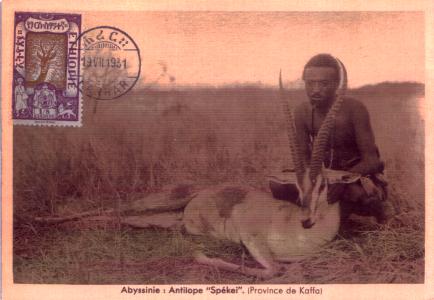 |
|
 |
|
1919 ANIMALS AND RULERS – ORIGINAL, PROVISIONALS AND REPRINTS
In 1917 Crown Prince Lidj Yassou abdicated the throne of Ethiopia under pressure for his Moslem beliefs. The crowning of Empress Zauditu and Crown Prince Ras Tafari (Haile Selassie) was commemorated philatelically by first a crude handstamp and second by a typeset overprint on the 1909 Definitive issue. A new set of stamps to commemorate the coronation was ordered from France with a 15,000 French francs deposit in gold. Because of the war in Europe the order was never completed and the deposit lost.
In 1918 the former Postmaster of Harrar, J. A. Michel, approached the then Minister of Posts, Wassanie Zamanel, a youth of 10-12 years. They made a secret agreement for a new issue of stamps for Ethiopia. However, Wassanie died of the Asian flu prior to the stamps being ordered. Early in 1919 Michel arrived in Switzerland with a letter of authorization to purchase the new issue. Michel’s brother, an employee of the Swiss post office, had selected Busag of Berne as the printer. Michel gave a guarantee of $40,000.00 Swiss franks in deposit, and printing began. Michel took possession of 500,000 to 100,000 of 15 different values, a portion of which were delivered to Ethiopia.
LETTER OF AUTHORIZATION:
“Addis-Abbeba, le 5 Septembre, 1918
Monsieur J. A. Michel,
Conseiller du Gouvernement
Addis Abeba.
Regarding the new stamps that I have ordered from
your brother in Switzerland last January 14. Her Imperial Majesty authorizes
me to grant you the following:
1. You can retain for sale to collectors a quantity
of stamps as long as the amount of the sale would cover the value plus
a commission of 10%.
2. Since you are in charge of all costs you will
retain the ownership of these plates and will have the right to reproduce
the stamps but solely for sale to collectors and this only after a delay
of 10 years from the day of the delivery of the order. On condition that
the Ethiopian Government does have recourse for a reimpression, or if the
Government in the meantime would have printed new stamps.
3. In any case, regardless, you cannot introduce
the stamps into Ethiopia without special authorization from the Government
at any time.
4. You will have the right to sell to collectors
mint or cancelled with the cancels of the Ethiopian Government as reproduced
below.
(Six postmarks)
(Signed - Wassanie Zamanel in Amharic and Latin
script)
As agreed with you I add that you drop your salaries
that the Government owes you for the last two years for the amount of $12,000
instead that you render your services for 3 years if we so desire without
any claim for salary. I have received your contract to counsel signed by
Bitiwold Haile Gorgis that I will send to the Government on guarantee of
our present agreement.
(seal of British Consulate, Lausanne).”
The letter of authorization became key in a later lawsuit against J. A. Michel for producing “forgeries.” Michel here explains his position in a letter to Ivan Adler in 1958.
MICHEL'S LETTER TO IVAN ADLER:
Excerpt from a letter from J. A. Michel, Grenoble, Switzerland, to Ivan Adler, Stockholm, Sweden, dated September 12, 1958.
"The first set of stamps came out 27th June 1919 in Addis Abeba and were put in circulation July 1919.
You speak about falsifications of Bela Sekula of 1930/31. This is a mistake because they were no falsifications but officially allowed reprints for collectors, which, I obtained personally from the Post Minister. Wassanie Zamanel was a young friend of Ras Tafari and so he received the permission of the Empress to do their treaty with me. The political situation was very critical at the time. Ras Tafari was having a campaign against King Michael of Wollo, the father of the abdicated Crown Prince Lidj Yassou. The Government’s treasury was bad or empty, and could not provide a new addition. Wassanie wanted to make an unexpected pleasure in producing new stamps without expenses and did not tell him about it. I myself was asked to be silent over the matter and had to give the guarantee of $40,000 in deposit. Unfortunately Wassanie died in November 1918 of the Asian Flu.
After the end of the guarantee in 1930 I made a new covenant with Bela Sekula and had reprinted them. There were very jealous philatelists in Berne who complained to Bela Sekula because of forged ones. There was a long court case but it finished with a "Nonlieu" because I had the original plates for which I could account thereof. The Ethiopian Government has then not admitted this issue of stamps or edition and has never paid for my recognized loss whereby my friendly and good relations were destroyed. This is the whole truth and I add a copy of the Stamp Collector's of 1936 from Harris and ask you to send it back after having taken notice of it.
The Minister of that time was 10-12 years old only and if he was brought up in Addis I must have known him and I must have his photograph."
Michel sold the original issue directly to the European stamp market, both mint and CTO. An unknown portion of the issue was sent to Ethiopia. Notably absent was the $2 value that is not known on cover. Some values are fond on gray paper indicating there were several printings of some values. Quantities delivered of the low values must have been insufficient, which partly explains the many provisional overprints of 1919-1928. Most high values were devalued as provisionals during this period, and postally used copies can be difficult to find.
Political stability and the treasury increased during the 1920s, and in 1928 a new issue arrived with only the portraits of Empress Zauditu and Ras Tafari. All prior issues of stamps were declared invalid for postage. In 1930 J. A. Michel negotiated a printing agreement with Bela Sekula to reprint the 1919 issue. During 1931 large quantities of these reprints began to appear in the European stamp market.
The Ethiopian Government advertised all its remainders for sale. In 1931 Thomas Cliffe, an English stamp wholesaler, eventually purchased a total of 1,048,221 stamps, many being the 1919 issue and its overprints. Cliffe did not want the 1919 issue without overprints as these could not compete with the reprints. As a result many of the high value remainders were overprinted at that time and were not valid for postage.
The only known proof of the original 1919 issue was the 8g rhino design that occurs in 80 different color combinations. During reprinting a number of varieties were produced that do not occur on the originals. These include imperforate, center inverted, center inverted and imperforate, frame only imperforate, center only imperforate, center double, center double one invert, wrong centers, etc.
REPRINT IDENTIFICATION:
The color differences are minor and not useable without comparison sets. The gum on the originals is smooth and can be compared to the gum on the 1919-1928 Provisionals. The gum on the reprints is cracked, usually diagonally, and often brownish. Used stamps can be identified by the cancels, with dates between 1919 and 1928 usually genuine. Some dates in 1919 are CTO in Europe with cancels AA4C, DD4B, and HR6A. Dates in 1931 or later are reprints. See CANCEL CATALOGUE.
Original  Reprint
Reprint
REPRINTS ON POST CARDS:
J. A. Michel printed a series of black and white post cards inscribed: "CARTE POSTALE Reproduction interdite – Collection Michel – Addis-Ababa." He affixed reprints to the face of these cards and cancelled them with the three devices in his possession. There are typically cancelled in 1931. These cards were never in Ethiopia. (please send a scan if you have addtional cards.)







